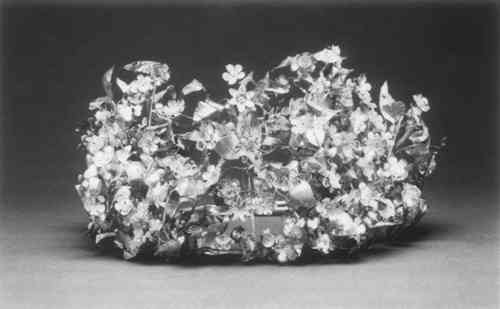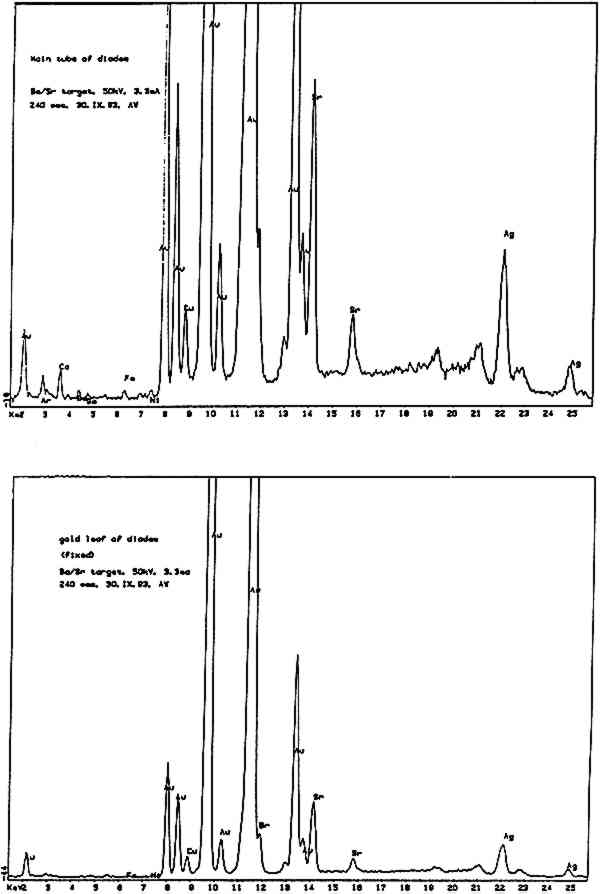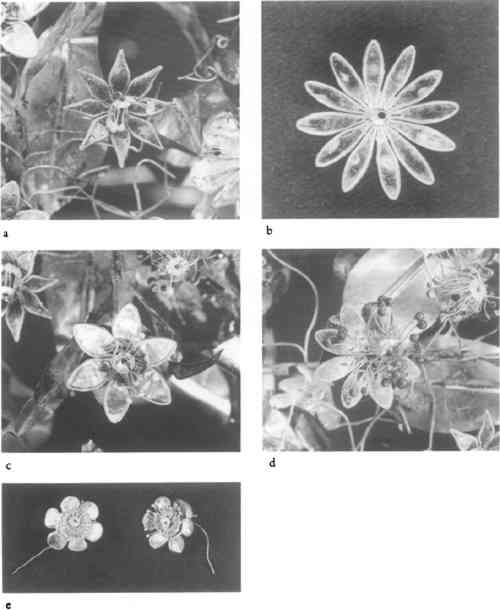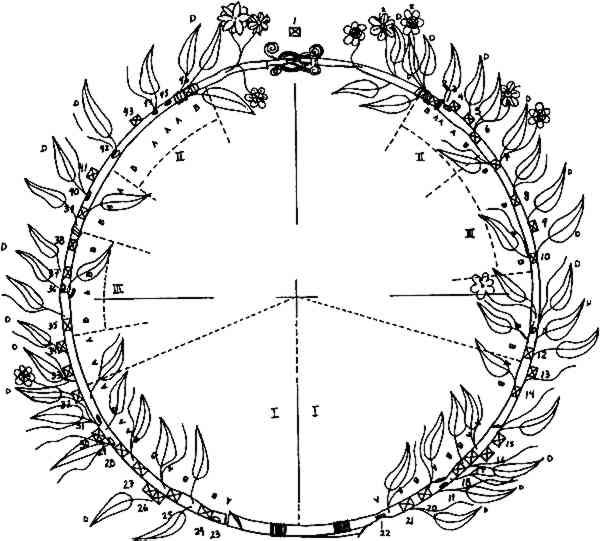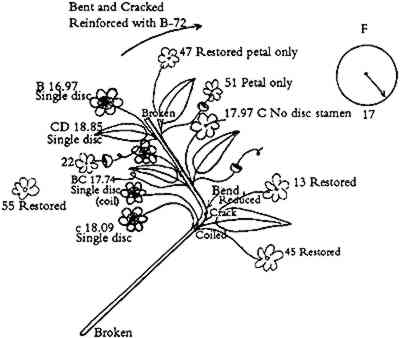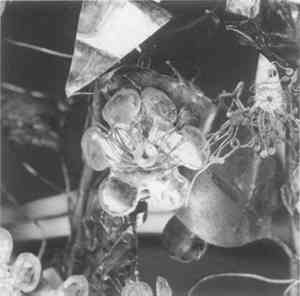INTERPRETATION OF ANCIENT ARTISTRY: CONSERVATION OF A GOLD WREATH FROM THE FOURTH CENTURY B.C.JEFFREY P. MAISH
ABSTRACT—The treatment of a Greek/Macedonian gold wreath from the fourth century B.C. brought forth many of the issues confronted by conservators of ancient materials. Different philosophical tenets influence current approaches to a particular treatment. The re-establishment of an understanding of intent for the ancient wreath rests on information offered by an external archaeological/art historical context, including purpose, context, parallels, and history, and more internal artifactual contex, including authenticity, level of completion, technical features, and logic or aesthetic. The process of technical and condition documentation helped clarify several issues and concerns in the course of treatment. 1 INTRODUCTIONThe conservation of antiquities demands a balance between the aesthetic considerations salient to the treatment of an object of art and the need to preserve the evidence remaining from an ancient object. Such a balance was sought in the treatment of an intricate gold myrtle wreath (93.AM.30) in the J. Paul Getty Museum (fig. 1). The work on the wreath involved thorough documentation of condition and technology; treatment of contemporary damage, which entailed some reshaping; and evaluation and reattachment of dozens of loose pieces. Despite the chaotic state of the wreath,
The passage of time generally degrades an object's condition, depletes the quality of information related to it, and obscures the artist's intent. Conservators believe, however, that treatment is indeed possible and the decision-making process then may be subjected to a series of broad philosophical precepts (van de Wetering and van Wegen 1987) based on information derived not only from contact with an artist but also from historical, art historical, and archaeological information. Additional insights are offered by inspecting the object itself, of course. Intent can only be reconstructed by relying on: (1) the art historical and archaeological information that gives an external context for the object and (2) the information offered by the object itself that might be called its internal context. These kinds of information may be further defined as follows:
2 ART HISTORICAL AND ARCHAEOLOGICAL CONSIDERATIONS2.1 PURPOSEWreaths of a similar type along with cremation remains have been found in northern Greece contained in small rectangular gold boxes (larnakes). Other examples have been found in which the wreath rests on the shoulder of an urn (Andronicos 1984). It may be said with a reasonable degree of confidence that their primary use was funereal and perhaps ceremonial. Even if they were used during their owners' lives, one would not expect to find a substantial amount of wear many repairs. It has been suggested that the wreaths might have been placed on the deceased immediately preceding cremation, and then removed at the last moment (Andronicos 1984). Evidence of fire-related damage has purportedly been found in similar wreaths. 2.2 CONTEXTThe wreaths excavated from tombs have been found in conjunction with a box-shaped larnax or an urn as mentioned in section 2.1. Contextual information of this kind, however, is rarely offered with market-purchased objects, yet even an excavation context offers no guarantee of furnishing the information required for a reconstruction. The conservator may once again have to rely on other factors that help interpret artist's intent and the original appearance of the object. In effect, the object itself becomes the primary source of information. 2.3 PARALLELSBased on published illustrations, the closest parallels to the Getty wreath appear in Macedonia: an oak wreath from Amphipolis (Andronicos 1984), two myrtle wreaths from Vergina (Andronicos 1984) and Derveni (Andronicos 1992), and an olive wreath from Stavropoulis (Ninou 1978, see also Williams and Ogden 1994). Details of the construction of the flowers appear very similar, with each foil flower consisting of multiple petals apparently joined with wire to other components including embossed discs and stamens 2.4 HISTORYThe history of an ancient artifact may be divided into two phases: the time immediately following its creation and the time after its discovery. An object is subject to alteration during both phases. In the former case, the alteration would be an informative addition to the piece. In the latter, however, any changes might obscure or even conflict with the original purpose of the object and lead to the incorrect interpretation of technical features and aesthetic intent. While modifications from burial also may form part of an object's history, in a sense these changes occur in a neutral environment without human intrusion, and they are part of the burial or archaeological record. Historical evidence following the object's creation may be classified as “use alteration.” Use alteration may take the form of wear patterns, ancient repair work, or other modifications. In the case of the Getty wreath, there are no identifiable signs of wear. There are some indications of repair, although the nature of the joins makes the repairs difficult to date. These indicators include unconventional twist joins, flowers with varying orders of assembly, and regular crimping patterns that suggest modern pliers were used. Evidence of pliers on the Getty wreath is visible on either side of the Herakles knot at the front of the wreath (fig. 2). The original join was probably made with a pressure fit in which a rounded tube was inserted over an elongated pin with squared sides
3 INFORMATION OFFERED BY THE ARTIFACT3.1 AUTHENTICITYX-ray fluorescence analysis of several locations on the wreath (fig. 3) suggests a gold-copper alloy consistent with ancient gold production methods (Scott 1993). The construction methods were similar to those employed on other wreaths. The sophisticated craft techniques included a construction method in which melting points used by separate manufacturing steps may have been successfully lowered.
3.2 STATE OF PRESERVATIONOur decision-making process depends in a large part on the state of the object's preservation. In some situations, specific details from one area of an artifact may therefore be used to reconstruct another area. This artifact's structure, intricate yet also repetitive, enabled some technical information to be transferred. A technical survey of the wreath aided in establishing its degree of completeness. The survey of the main support tube showed that out of 46 possible spikes or points of attachment for branches, only 26 branches remained. What were initially 3.3 TECHNICAL FEATURESInitially, wire and foil were manufactured through methods that included hammering, stamping, twisting, and coiling. Segments of the manufacture such as foil and wire production could have been independent operations, although these components also may have been part of the wreath production method. Lengths of twisted wire would have been produced by rolling thin strips of gold foil into small, tightly coiled tubes. More detailed components such as the flower petals and stamens could have been formed in large quantities at an early stage for later assembly into complete flowers. The main support of the wreath was formed from two curved and tapered tubes. Spikes were then soldered on for the tubes of the branches (fig. 4). The two tube halves were joined at the rear with wire looping and at the front with a decorative Herakles knot (fig. 5). The branch stems were formed separately from smaller diameter tubes. Heavier gauge wires were inserted through punched holes in the tubes and then flattened and trimmed to form leaves. Flowers were assembled on wires that had been previously attached to the branch tubes. Each flower consists of three or possibly four components including a hemispherical support, a group of petals, and either a wire stamen or a single or double ring disc. In some instances a plasterlike core remained in the interior of the hemispherical portion of the flower. The plaster core may have supported the gold foil during forming but probably also gave the flower further structural support, or its added weight may have played an aesthetic role by allowing the flowers to sway. The petals may have been produced by stamping. The regularity of the shapes and sizes, suggests stamping, as do the matching outlines of two petal groups on one stem. A gradual bowing of the flowers' profiles also suggests stamping or punching.
Soldering and heating most probably was carried out in a small oven capable of approximating the melting point of fine gold at 1063�C (Untracht 1975). The stamens (fig. 6) were produced using the following techniques in succession. After the preliminary mechanical working was completed, the artisan might have executed higher-temperature forming to shape the rounded tips of a stamen, followed by lower-temperature joining of individual parts of the wreath. Finally, a low-melting-point glass was added to some areas. Anthers of blue glass globules were fused to the tips of some wire stamens, and blue glass was added to color several flower petals. Bubbles or “seeds” in the glass are highly suggestive of lower-temperature work (Newton and Davison 1989). In addition to gas bubbles, environmental Scanning Electron Microscopy inspection of the glass surface (fig. 7) of one petal group shows the incomplete mixing of the glass components, another indication of fairly low-temperature glass working.
3.4 AESTHETICSome contemporaneous Lucanian wreaths from the fourth century B.C. include fanciful details in their design (Deppert-Lippitz 1985). Ornate elements such as star-shaped flowers and erotes, in one example, contrast with the more naturalistic aesthetic of the Getty wreath, which belongs to a group of wreaths possessing a significant degree of botanical accuracy When compared in photographs to a real myrtle branch, the accurate details of the Getty wreath can be seen to include the shape of the flowers and the leaves. The variable leaf size and tapering stem diameters also suggest natural growth patterns (Polunin 1969). This tradition of the naturalistic representation of plant life also seems to have included depictions of ivy, oak, and olive branches. In a departure from absolute naturalism, the creator of the Getty wreath has inserted a mixed grouping of colored glass flowers at the front variously described as gentian or campanula, and even one example of a presumably imaginary flower with alternating blue and green petals (fig. 8).
Despite the seemingly random organization of the wreath, a careful examination revealed an underlying design. Spikes were soldered to the main branch tube in a roughly symmetrical pattern with some branches facing upward and forward, while others faced upward, forward, and slightly outward (fig. 9). It follows, therefore, that the branches, too, were arranged in a distinct pattern. Symmetrical placement is also found in the individual branches in which leaves were positioned opposite one another. The sum of the parts of the wreath was combined, however, to create a naturalistic and aesthetically gratifying design.
Each of the wreath's 26 individual branches was sketched, numbered, and mapped for technical features (fig. 10). The approximate sizes of the flowers were measured as well, and four distinct dimensions were noted as A, B, C, or D with sizes ranging from 15 to 20 mm. This range indicates that the artisan was interested not only in depicting a wreath but also in creating branches with variable vertical growth. Flower sizes were also noted by quadrant to show their horizontal distribution. One quadrant in particular was “depleted” of flowers. Although they were not surveyed, several leaf sizes could be noted on the wreath as well. Different design elements were also noted. Stamens, for example, were either of the less
To all of this one may add the depredations of time, arising from the object's own chemical composition and its environment. In this case the surface alteration was generally minimal and confined to a light calcareous layer on some leaves. Several of the flowers, however, appear to have a high mirrorlike finish on one side (fig. 11). The question remains as to whether this effect is a result of an intentional finishing process, variable weathering during burial, or perhaps an uneven cleaning
4 TREATMENTFollowing the evaluation of the wreath, the treatment progressed with the reattachment of loose floral elements, repair of damaged or weakened areas, and straightening of severely tangled areas. The orientation of some leaves and flowers was also changed to more closely approximate “botanical” realism. Finally, bending was reduced on several leaves and branches. In general, however, the treatment was restrained and minimal. Floral elements were replaced in a manner consistent with the proposed installation of the artifact. Although the front of the wreath was predominant, the flowers were distributed to logically fill in depleted areas. The idea was to create not only greater horizontal symmetry or balance but also vertical balance. The options to emphasize the front only for display or to distribute the flowers randomly were rejected as conflicting with the underlying order to the wreath. Following the survey, 54 detached flowers were reattached to create a better balance in each quadrant of the wreath. The floral elements Bends in several branches were reduced. This process was complicated in areas where tubing had cracked and collapsed. As it was not possible to reach the interior of the wreath tube to support the tube walls, reshaping had to be accomplished externally. Instead, a hole of the approximate outside diameter of the gold tubing was drilled through small pliers, the mouth of which was cushioned with tape to prevent scratching. Then the pliers were gently crimped and carefully “walked” up the bend in the tube. The hole in the pliers offered sufficient support for the outer wall of the gold tubing by distributing the forces more evenly. Reducing bends served to bring several branches nearer to their original heights. Loose branches were reattached to the nearest spike location. A plastic dowel inserted in a rear break in the main branch tube was also secured with Acryloid B-72 (50% in acetone). Surface cleaning was confined to the removal of loose lint material. Several leaves had calcareous deposits, which were left in place. Straightening of leaves was confined to the use of finger pressure. Each leaf had a central “V” contour, and no attempt was made to press or burnish the leaf to obtain a perfect surface free of blemishes. Individual wires and leaves were untangled and raised to an upward orientation. Several leaves attached to the main wreath tube had been pressed up into the wreath probably by the continual laying of the wreath on a flat surface. The orientation of attachment suggested a downward orientation, so these leaves were bent slightly down. These leaves were further protected by displaying the wreath on an elevated mount. 5 CONCLUSIONSThe treatment did not produce as naturalistic an impression as may have been intended originally, but it reflects our present knowledge of the wreath. The original artist may have wondered at such close scrutiny, but the scrutiny did result in a more accurate presentation (fig. 12). It also came as a surprise that underlying the seeming chaos of the wreath, there was a certain logic that presented an interesting aesthetic balance between logic and artistry. The recovery of this underlying sense of order, together with the repair work, has brought forth in the wreath a greater sense of life.
ACKNOWLEDGEMENTSI would like to thank the staff of the Antiquities Conservation Department, J. Paul Getty Museum, in particular Jerry Podany, head of conservation, for their many valuable suggestions and insights into the treatment. I would also like to acknowledge the assistance of Karol Wright, Antiquities Curatorial Department for art historical background on the wreath and Arie Wallert, David Scott, and Eric Doehne, the Getty Conservation Institute for their scientific investigations of the wreath. Finally, I would like to thank the members of the Photographic Services Department of the J. Paul Getty Museum for the documentation photographs they provided REFERENCESAndronicos, M.1984. Vergina: The royal tombs and the ancient city. Athens: Ekdotike Athenon, S.A. Andronicos, M.1992. Thessalonike museum. Athens: Ekdotike Athenon, S.A. Deppert-Lippitz, B.1985. Griechischer goldschmuck. Mainz: Verlag Philipp von Zabern. Newton, R., and S.Davison. 1989. Conservation of glass. London: Butterworths. Ninou, K., ed.1978. Treasures of ancient Macedonia. Athens: Archaeological Museum of Thessalonike, J. Dekopoulos and A. Petroulakis and Co. Polunin, O.1969. Flowers of Europe: A field guide. London: Oxford University Press. Polunin, O., and A.Huxley. 1978. Flowers of the Mediterranean. London: Chatto and Windus. Scott, D.1993. Personal communication. Museum Services, Getty Conservation Institute, Marina del Rey, Calif., 94202. Untracht, O.1975. Metal techniques for craftsmen. Garden City, N.Y.: Doubleday. van deWetering, E., and D. H.vanWegen. 1987. Roaming the stairs of the Tower of Babel: Efforts to expand interdisciplinary involvement in the theory of restoration. ICOM Committee for Conservation preprints, 8th Triennial Meeting, Sydney. Paris: ICOM. 2: 561–65. Williams, D., and J.Ogden. 1994. Greek gold: Jewelry of the classical world. New York: Harry N. Abrams. SOURCES OF MATERIALSAcryloid B-72H. Marcel Guest Ltd., Riverside Works, Manchester, M10 7RU U.K. AUTHOR INFORMATIONJEFFREY P. MAISH is an assistant conservator in the Antiquities Conservation Department of the J. Paul Getty Museum. He received his master of arts degree from the Art Conservation Department, State University College at Buffalo in 1987 with an objects specialty after completing an archaeological conservation internship at the York Archaeological Trust, York, England. His interests include radiography, the development of molding and casting techniques, and research into methods of exhibit case and storage desiccation. Address: Antiquities Conservation, J. Paul Getty Museum, P.O. Box 2112, Santa Monica, Calif. 90407.
 Section Index Section Index |
